 |
|

|
 |
TABLE of CONTENTS
 |
Exhibit provides educational snapshot of tribal, government relationships |
By Libby Schultz
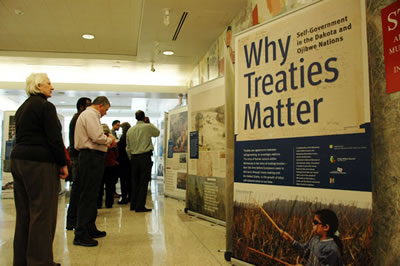
Merry Daher, State Aid for Local Transportation Division (foreground), joined other state employees Jan. 3 in MnDOT's Central Office to view the travelling Why Treaties Matter display. Photo by Libby Schultz |
The Why Treaties Matter exhibit made its way to MnDOT’s Central Office Thursday, Jan. 3, after traveling to Minnesota schools, reservations, learning centers and other state agencies last year.
The exhibit illustrates the history of treaties between tribal nations and the U.S. government, and the stories of sovereignty, adaptability and sustainability.
“The exhibit is an excellent snapshot of history and how the treaties are binding agreements that still matter today,” said Linda Aitken, tribal liaison for the Office of Government Affairs.
Today, 11 tribal governments in Minnesota exercise political sovereignty and treaty rights. The Why Treaties Matter exhibit is an educational tool for people across Minnesota, including employees of state agencies.
“Our responsibility is to work with each tribal government and consult with and communicate on issues that affect their government or tribal members,” said Aitken.
State agency employees are required to involve the tribes on issues of mutual interest. Some of the policies and programs that involve the tribes include trust lands, rights of way, Indian employment on or near reservations, road safety, reservation road signs and collaborating on highway projects within a reservation.
“As a state agency, MnDOT has a government-to-government relationship to the 11 tribes of Minnesota,” said Aitken. “This exhibit is intended to help educate us so we may have a better understanding of the tribes that we serve and have a working relationship in many transportation areas today.”
The Why Treaties Matter exhibit is a collaboration of the Minnesota Indian Affairs Council, the Minnesota Humanities Center and the Smithsonian Institution’s National Museum of the American Indian. The exhibit will be at MnDOT until Jan. 31.
For more information:
|
 |
|

|
 |
TABLE of CONTENTS
 |
Community celebrates Hwy 210/Thomson Bridge project completion |
By Beth Petrowske, District 1 public affairs coordinator

Local government officials prepare to cut the ribbon. MnDOT and Jay Cooke State Park staff and members of the community help hold the ribbon. Photo by Beth Petrowske
|
About 85 people braved a cold, sleety-rain to attend a ribbon-cutting event at the Hwy 210/Thomson Bridge Saturday, Dec. 15. Following the ceremony, everyone was invited to the Thomson City Hall for refreshments and live music.
“This project is a good example of MnDOT’s ability work cooperatively with local communities and various agencies while responding quickly to natural disasters,” said Duane Hill, District 1 engineer.
“On behalf of the citizens of northeastern Minnesota, I want to thank the MnDOT and other agency employees as well as our contractors who worked so diligently to help restore the damage caused by the June flooding and complete the project that was planned prior to the flooding event at this location.”
The bridge had been closed for six months for a rehabilitation and flood-repair project. In addition to the regularly scheduled project, a new, 110-foot-long bridge was built on the west end of the existing bridge to replace an 18-foot-diameter overflow pipe that was destroyed during the June 2012 flood.
The bridge rehabilitation project included:
- Structural steel repairs
- Gusset plate replacement/reconstruction
- Replacement of riveted connections with bolted connections
- New expansion joints
- New concrete bridge deck and rail
- Concrete repairs/patching on the bridge abutment and wing walls
- Bridge painting
- New concrete approach panels
The only road still closed as a result of the June flood is Hwy 210 from the eastern edge of the Jay Cooke State Park campground to Fond Du Lac. A 50-foot-deep, 250-foot-wide gash in the highway remains to be repaired in this section. Bridge and roadway stabilization plans are being developed for reconstruction in this heavily damaged area.
MnDOT has spent more than $12 million constructing temporary and permanent flood-related repairs. The total amount of damage to the highway system is more than $50 million.
See also:
|
 |
|

|
 |
TABLE of CONTENTS
 |
Research funding awards focus on high-value projects |
|
By Nick Busse, Research Services
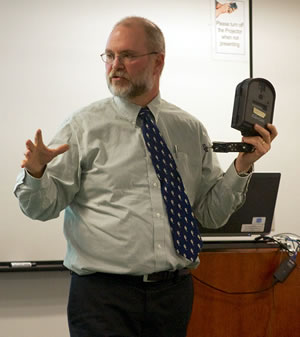
Assistant Professor Stephen Druschel of Minnesota State University, Mankato, presents his proposal for research on salt brine blends to members of the Transportation Research Innovation Group Dec. 3, 2012. Druschel is holding camera equipment that will be used in his project. Photo by Nick Busse |
Improved bridge inspections, more effective salt blends and better tools for managing work-zone delays are among the many goals for MnDOT’s next round of research projects.
The Transportation Research Innovation Group announced its funding awards for Fiscal Year 2014 research projects Dec. 14. Known by its acronym “TRIG,” the group reviewed proposals in early December and selected a total of 16 research projects for funding.
“This is really a great selection of projects that address some of MnDOT’s top strategic priorities, focusing on improving the safety, efficiency and cost-effectiveness of the department’s operations,” said Linda Taylor, director of Research Services.
Among the list of funded projects is a phase-two study of the effectiveness of various salt compounds for deicing and anti-icing. Steve Lund, state maintenance engineer, said research like this can potentially yield significant benefits to snow plow crews fighting the kind of adverse weather conditions that followed the Dec. 9, 2012, blizzard.
“MnDOT already has some of the best snow plowing operations in the country; better understanding of the costs and benefits to different approaches to deicing and anti-icing will allow us to become even more effective,” Lund said.
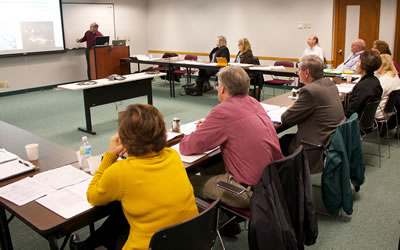
The Transportation Research Innovation Group, or TRIG, meets quarterly to review transportation research proposals and recommend investments. Photo by Nick Busse |
TRIG is the governing board for the State Research Program. Comprising representatives from various MnDOT offices and districts, the group is tasked with reviewing and approving investments in transportation research projects of interest to the state. Additional funds are leveraged through partners including the Local Road Research Board and the Metropolitan Council.
All research projects are monitored and administered by technical advisory panels. Those interested in participating in a TAP for one or more of these projects are welcome to contact Linda Taylor at linda.taylor@state.mn.us or 651-366-3765.
The group awarded funding to the following projects:
- Minnesota Steel Pipe Service Life Map*
- Enhancement and Application of MIDS Dry Swale Calculator
- Evaluation of the Effectiveness of ATM Messages Used During Incidents
- Next Generation Bridge Management Tools and Inspection*
- Impact of Lower Asphalt Binder for Coarse HMA Mixes
- Investigation of Optimal Mix Design of Full Depth Reclamation Stabilization with Cement and Emulsion*
- Salt Brine Blending to Optimize Deicing and Anti-Icing Performance and Cost Effectiveness Phase II
- Effect of temperature on PC strand stress during construction
- Transportation Planning to Support Economic Development in Minnesota
- Strength Required to Open to Traffic
- Travel Behavior Over Time
- Development of a Guideline for Work Zone Diversion Rate and Capacity Reduction**
- Exploring Strategies for Promoting Modal Shifts to Transitways
- Develop Annual Arterial Congestion Report
- Flagger Operations: Investigating their Effectiveness in Capturing Driver Attention*
- Sensing for HOV/HOT Lanes Enforcement
*Projects funded jointly with the Local Road Research Board.
**Fifty percent cost share with the Metropolitan Council. |
 |
|

|
|

|
 |
TABLE of CONTENTS
 |
Donated vacation hours sought for District 3ís Dave Schwarting |

Dave Schwarting, principal engineer with District 3/St. Cloud’s Construction office, awaits a heart transplant after suffering a heart attack in July. He is an eligible recipient for the state's vacation donation program. Photo courtesy of District 3 |
Dave Schwarting, principal engineer with District 3/St. Cloud’s Construction office, has exhausted all of his sick and vacation leave due to a serious illness and has been approved as a recipient under the state’s vacation donation program.
Schwarting suffered a heart attack in July and underwent open heart surgery. He was implanted with a heart pump to help him recover while he awaits additional surgery, including a possible heart transplant.
Schwarting has been a MnDOT employee since 2006.
The state vacation donation program allows employees to donate up to 40 hours vacation per fiscal year to approved recipients.
To donate vacation leave:
- Go to Employee Self Service Website, click on “Other Payroll,” then “Leave Donations.”
- Select the magnifying glass next to “Reserve Bank” and choose Schwarting’s name
- Enter the number of hours you wish to donate
- Click on the yellow “Save” box
Donation forms are also available from your Payroll or Human Resources office or at www.mmb.state.mn.us/doc/vacation/pe665.pdf . |
 |
|

|
 |
TABLE of CONTENTS
 |
Joe Pignato named Real Estate and Policy Development assistant director |
By Becky Dahlberg

Joe Pignato. Photo by Becky Dahlberg |
Joe Pignato became the Real Estate and Policy Development Section assistant director Jan. 2, a position he has been acting in since March 28, 2012, when Mike Stensberg retired.
Pignato has 15 years’ experience with the department in Consultant Services, Utilities and Right of Way, and he held mobility positions in various areas including Streamlining and Government Affairs, as well as serving as the West Area Engineer for Metro District.
Prior to his career with MnDOT, Pignato worked as a consultant engineer for LHB Engineers and Architects, Inc. He holds a bachelor’s degree in civil engineering from North Dakota State University.
Pignato’s office is on the eighth floor of Central Office. His new phone number is 651-366-3503.
|
 |
|

|
 |
TABLE of CONTENTS
 |
Aeronautics Flight Schedule tool offers option for saving travel time, expenses |
By Dan McDowell, Office of Aeronautics
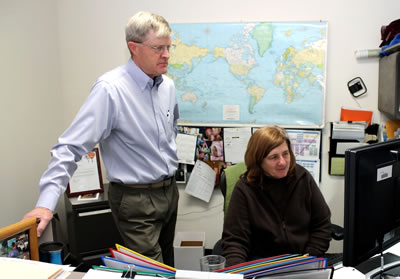
Chief pilot Barry Erickson and flight scheduler Barb Lovness review the current aircraft schedule. Photo by Dan McDowell |
“At a time when everyone’s time and budgets always seem to be in short supply, looking for ways to save human and capital resources is critical,” said Barry Erickson, chief pilot for the Office of Aeronautics. “Depending on the destination, flying out and back the same day can result in saving time and travel expenses.”
What Erickson is talking about is the new Aeronautics Flight Schedule that was recently added to MnDOT’s website. It is a link to the aircraft flying schedule where employees can see destinations and times for flights on a select day. It also provides information on the number of available seats.
When employees find a time and date that fit their schedule, they should contact Vee Dellwo or Barb Lovness at 651-234-7222 or aircraftschedule.DOT@state.mn.us to reserve one of the seats.
“This will help us to more effectively and efficiently use our planes by increasing the passenger load,” said Lovness, air transportation flight scheduler. Interested flyers should note that after someone else has already scheduled the flight, there is no additional cost to MnDOT for them to reserve one of the available seats.
“If your business needs require travel to greater Minnesota and your schedule is flexible in times and dates of travel, this is a great way to save significant travel time and money while completing your outstate business within your normal work day,” Erickson said.
|
 |
|

|
 |
TABLE of CONTENTS
 |
Agency opens doors to Windows 7; time to get ready |
Early in 2013, MnDOT will begin switching to the Windows 7 Operating System for all its workstations.
An operating system controls and runs just about everything on workstations, including hardware and programs, and organizing files. Windows 7 offers several new features to help users work faster and more efficiently by accessing files, folders, programs and applications quickly. Users may already be familiar with Windows 7 if it’s used on a home computer. For people who have not used Windows 7, it may take a little getting used to.
|
Employees should begin preparing now by going through the data stored on their workstations—including the hard drive and desktop—and deleting anything that is not needed. |
Planning for the move to Windows 7 is currently underway. When the new software is pushed out to employees’ workstations, files that are stored on the desktop or hard drive can cause problems. Employees should begin preparing now by going through the data stored on their workstations—including the hard drive and desktop—and deleting anything that is not needed. Any necessary business data should be saved to the appropriate network drive or the workstation’s “My Documents” folder.
Peter Zuniga, Office of Chief Counsel, said that before employees delete any documents from their desktop or hard drive, they should make certain documents are not subject to any litigation holds and follow MnDOT’s approved retention schedule. For more information on litigation holds contact Zuniga at 651-366-4837 or peter.zuniga@state.mn.us. For more information on MnDOT’s retention schedule see http://ihub.dot.state.mn.us/retention/ or contact Pam Newsome, Records Management, 651-366-3067, or pam.newsome@state.mn.us.
Information about Windows 7, including videos and quick-start instructions, will be posted on a new Windows 7 webpage that will be available soon. Employees will be notified via email when the webpage is available.
The transition is expected to take at least one year.
For more information contact Karen Scott, IT project manager, 651-366-4028, karen.scott@state.mn.us. |
 |
|

|
 |
TABLE of CONTENTS
 |
Guest wireless service to be offered at most large MnDOT facilities† |
Industry partners, vendors and other visitors who have business with MnDOT staff soon will have guest wireless access available to them at most of the agency’s larger facilities, according to Nic Bacigalupo, North Regional Infrastructure supervisor, MN.IT Services @ DOT.
The free service already has been installed at Central Office and District 3/St. Cloud headquarters as part of an earlier pilot program. Beginning this week, service will be turned on at Arden Hills, District 3/Baxter and District 6/Rochester and Owatonna, with other facilities scheduled for implementation during the next few months.
Tto use the service, guest wireless users must:
- Have a MnDOT sponsor who confirms the business purpose of the guest
- Provide a government-issued photo ID, such as a driver’s license or passport
- Be at least 18 years old
- Accept the Terms of Use Agreement as part of the log-in process
The MnDOT sponsor is responsible for coordinating the guest wireless account setup with the lobby ambassador for their building. Once the account is enabled, access lasts for 12 hours. However, no technical support is provided to the guest wireless user. MnDOT employees will not have access to the guest wireless service.
MN.IT@DOT will be coordinating the implementation of the wireless service at these additional MnDOT sites:
- Week of Jan. 21 – Metro (Waters Edge), District 2 (Bemidji, Crookston and Thief River Falls)
- February – District 1 (Duluth and Virginia) and District 4 (Detroit Lakes and Morris)
- March – District 7, Metro District (Maplewood) and District 8 (Willmar, Marshall and Hutchinson)
- April – Metro District (Oakdale and Golden Valley), Fort Snelling and Aeronautics
The guest wireless service is separate from the wireless service offered by MnDOT Library in Central Office, which limits users to the library area. Guest wireless allows access in other areas of the MnDOT facility.
For a more detailed description of guest wireless service and responses to FAQ’s, see http://ihub/information/general/guestwireless.pdf. Questions about the service can be addressed to Nic Bacigalupo at 218-725-2739 or nic.bacigalupo@state.mn.us. |
 |
|

|
 |
TABLE of CONTENTS
 |
Hwy 169/Pokegama Avenue reconstruction project wins multiple awards |
By Beth Petrowske, District 1 public affairs coordinator
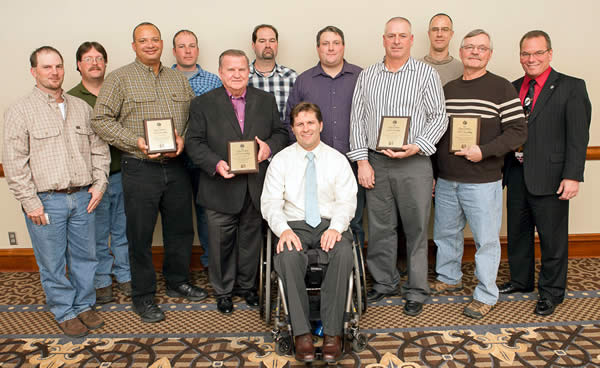
MnDOT District 1 staff and contract partners picked up three awards recently from the Minnesota Asphalt Pavement Association for work done on the Hwy 169/Pokegama reconstruction in Grand Rapids.
Pictured here
(front, left to right) are Scott Danielson and Dana Marrier, MnDOT; Tom Hammerlund, Sr., Hammerlund Construction; Todd Grugel, MnDOT; Jim Fore, Knife Lake Concrete; Glen Weston, Hawkinson Construction; Bernie Arseneau, MnDOT.
(Back, left to right) Steve Ullmann, MnDOT; Brian Anderson and Tad Lofstrom, Hawkinson Construction; Dominic Ellison, Hammerlund Construction; Kevin Rohling, MnDOT. Photo courtesy of Minnesota Asphalt Pavement Association |
MnDOT District 1 received three awards from the Minnesota Asphalt Pavement Association for the reconstruction of Hwy 169 in Grand Rapids.
The project received a Work Zone Safety award in the Static High Volume category, an ADA Accessibility award (the first accessibility award ever presented) and an Asphalt Paving award in the Reconstruction, Low Volume Traffic category.
“This is a project that we can all be proud of,” said Mike Tardy, District 1 Program Delivery engineer. “MnDOT had a great team working together on this project, including the city of Grand Rapids, SEH, Inc., and local contractors, including the prime contractor Hammerlund Construction, Inc., Hawkinson Construction Co. Inc., Itasca Utilities, Keller Fence Company and Deer River Trucking Co., Inc.
“We want to thank everyone, including the citizens of Grand Rapids and local businesses for their patience and support of this project,” he said.
The project included the complete reconstruction of Hwy 169 from First Street to 10th Street S. and an overlay extending to Third Street N. and to 13th Street S. and a new center turn-lane to separate through-traffic from turning traffic. This safety improvement will reduce rear-end collisions and improve traffic flow. The project also included pedestrian accessibility and safety improvements including:
- A new traffic signal at 4th Street S
- Updated visual, audible and tactile pedestrian traffic signals
- Pedestrian ramps and landings
- Detectable warning surfaces (truncated domes at the pedestrian ramps)
- Accessible pedestrian signals with push-button stations
- Marked pedestrian crossings
- New sidewalks on both sides of Hwy 169
Projects were judged on teamwork and dedication to improving Minnesota’s infrastructure in a safe, efficient and economical manner.
For more information about the Hwy 169/Pokegama reconstruction project, see www.dot.state.mn.us/d1/projects/Hwy169poke/index.html. |
 |
|

|
 |
TABLE of CONTENTS
 |
Book discussion set for Feb. 6 |
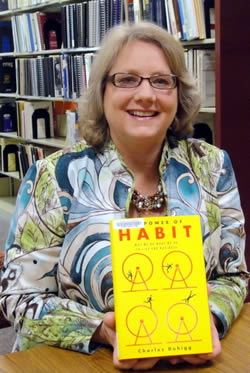
Karla Rains. Photo by Qin Tang |
Employees are invited to attend the latest Commissioner’s Reading Corner discussion on Wednesday, Feb. 6 at 1:30 p.m., in the MnDOT Library at Central Office.
Karla Rains, Customer Relations director, will lead a discussion of The Power of Habit: Why We Do What We Do in Life and Business by Charles Duhigg.
Employees also can participate virtually via Adobe Connect and should log in as a guest no earlier than 1:15 p.m. All employees are encouraged to attend, even if they have not yet read the book.
For more information on the Commissioner’s Reading Corner, visit ihub/readingcorner or contact Qin Tang, MnDOT librarian, at 651-366-3784.
An interview featuring Rains’ reaction to the latest book will be posted on the ihub/readingcorner website. |
 |
|

|
 |
TABLE of CONTENTS
 |
Employees share generously during the holidays |
By Becky Dahlberg

St. Cloud employees pack toys to donate to Toys for Tots. Photo courtesy of District 3
|
Employees from across the state donated toys, food and money to different charities this holiday season. Here’s a snapshot of some of the fundraising efforts:
District 1
Duluth employees held a Toys for Tots drive and donated 46 toys.
District 2
Bemidji employees raised $118 for the Children’s Cancer Research Fund and collected blankets, puzzles, movies, bathrobes and other items, which were donated to the Good Samaritan Nursing Home in Blackduck.
District 3
St. Cloud employees donated $1,315 and 81 toys to Toys for Tots, and $190 and 128 pounds of food to the St. Cloud Area Food Shelf. Baxter employees raised $1,153 for the Toys for Kids program in southern Crow Wing County.
District 4
Employees and retirees from MnDOT and the Department of Public Safety in Detroit Lakes area raised $2,120 for Hospice of the Red River Valley during their charity potluck.
District 7
Employees participated in a Minnesota State Patrol District 2200 Toys for Tots drive, and sent cards and a care package to Sgt. Dave Ivers, a Mankato shop supervisor serving with the National Guard in Afghanistan. They also held a small food drive in coordination with a Christmas potluck.
Central Office
Employees held a food and donation drive and collected $1,600, to which the Hiway Federal Credit Union donated an additional $500 for a grand total of $2,100. Proceeds went to Sharing Korner, Merrick Community Center, Neighborhood House and Ain Dah Yung Center.
Bridge Office
Oakdale employees held a Caring and Sharing Hands drive and donated more than three vans-full of gently used clothing, toys and blankets. Employees also held a silent and live auction and raised $2,307 for the emergency food shelf network in New Hope.
Office of Finance
Employees tried something new and turned their holiday fundraiser into a competition to see which half of the office could raise the most money for St. Jude and Gillette Children’s charities. They donated more than $500 to each charity. |
 |
|
| |
|



